If you have a baby like mine, only a warm bottle will do when it’s time to eat. When power is up and running, or when you’re in the comfort of your own home, this isn’t an issue at all. Remove the wall outlet from the equation at home, or find yourself on the go in a lengthy car trip and heating up the bottle in a timely and efficient manner becomes an interesting experience.
A hungry baby leads to screaming in a hurry if you don’t take care of the problem when the warning signs first start. In the darkness of a power outage or caught on a long highway, you can be left feeling helpless and frustrated as the screaming decibels get louder and louder.
If on the go or when the power is out, the easiest methods to warm a bottle involve your vehicle battery or a gas or propane stove.
- Use a 12-volt, wrap-around bottle warmer when while driving
- Hook an inverter to the car battery and plug a tabletop bottle warmer into it
- Warm the water directly or double boil milk on stove
I’m going to guide you through the steps that my wife and I took to warm a bottle during a power outage, and also when traveling. Most of these solutions cost very little and save so many headaches, frustration, and feeling like a failure to your little one when they need you most!
It’s easy when I’m home in the kitchen and the power works!
Believe it or not, but finding the answer to this problem was what first started me on my journey from going from a “zero state of preparedness” for a power outage, to one that I think will take me through several weeks without an issue.
It was winter in the tail end of 2014 and my daughter was only a little over a month old. The evening was going as usual, and suddenly the lights simply failed. Nothing. Just the ticking sound of clocks on multiple walls.
We had just decided to join the rest of the world by getting smartphones a few months prior (2014…I know, I know….), so those became our source of light to begin to navigate around the house. I quickly realized that I didn’t care so much about a power outage when I was single, or even when I was married. Good times by candlelight and board games, right?
Now I had a daughter counting on me and I couldn’t even find a flashlight. My priorities quickly changed as she grew restless and started whining for a bottle. Luckily I still had a little residual water from our pressure pump (we have well water so no water for us in a storm), but beyond the small amount that would come out for the first bottle or so, I didn’t have a backup plan for more water.
Luckily the power was only out a few hours, but I was caught completely ill-prepared and deep in my chest my status as a parent was clearly at a failing grade. How am I supposed to raise this beautiful girl when I can’t even protect her from a basic power outage?
So began my journey to build systems of redundancy so that such a situation never happens again. I quickly found out how my preparedness for a power outage in the home can transfer to the scenario of a long car ride.
Let’s start with what I feel is the most important supply on hand, followed by the most important tool.
The supply to have: Water
It’s obvious that water equals life, even Zoolander had something to say about it. Hydration, sanitation, hygiene, cooking, even heating a bottle in the warmer all happen because of water. Before anything else, store up some potable drinking water for you and your family.
Everyone’s situation is different so it’s hard to give a recommendation on how much you need, but simply having 10-15 gallons of stored water (store bought or stored yourself) will probably get you through most power outages that you will encounter (depending on the frequency and duration).
If your child is using formula they’ll need it to mix, and you’ll need water to warm the bottle regardless.
My wife and I opt to clean our house with distilled white vinegar instead of harsh chemicals. I always wash out and reuse the empty jugs. The plastic is thicker and is more durable. One wash with normal dish soap and a rinse or two with hot water and you will not have a vinegar aftertaste in your water. I was skeptical at first too!
Try to stay away from milk jugs if you can help it. First, they are prone to leaking since the plastic is designed to decompose quickly. Second, if you don’t properly clean them (interior and the rim), you risk contaminating the water with leftover milk enzymes and proteins. Hello, bacteria!
I cover my water storage methods here in another article if you’d like more information.
The tool to have: 800- watt DC/AC Power Inverter
If you’ve heard of this item, awesome! However, if you’re like me, you squinted a little and said, “what the heck is that?!”
Let me introduce you to what I feel is the handiest little device that literally every household should own, hands down, no questions asked! Well, maybe a few.
What is it? Brand aside, it is simply a gadget about the size of a box of baby wipes that can save your butt when the power goes down or when you’re on a road trip. It takes power from your 12-volt car battery (or any 12-volt battery which has direct current (DC) electricity) and switches it to alternating current (AC) like your walls supply so that you can power things in your house.
You literally turn your car into a generator!
Without a doubt, it has been one of the top 3 things I’ve ever bought in my life that have really given me 1000% return on investment.

An 800-watt power inverter, coupled with your car’s battery and an extension cord equals a warm bottle and a happy baby. Of course, you could run lights off of it, charge cell phones, a small TV, etc. as well.
You can buy one for well under $100 and if you’d like to see the lowest current price of the one that I use and recommend, you can click here to see what Amazon has to offer.
When the power goes out at home
When I was first bought my power inverter shortly after the power outage I first told you about, I got to use it for the first time in the spring. The outage happened in the daylight, and I was simply able to go out to my car and pop the hood.
With the car running, I hooked the red clamp from the inverter onto the positive terminal of the battery, and the black clamp to the negative. I powered the unit on, plugged in an extension cord, ran it into the house, and plugged the bottle warmer into it.
I added the required amount of water (from my new supply) to the bottle and to the warmer. I pressed the button and MAGIC! It’s like nothing ever happened with the power supply. The baby was happy, and we still had plenty of daylight to get things ready for an evening without it. Luckily it came back on before it got dark.
The bottle warmer that we have in our house uses 300 watts, so an 800-watt inverter is perfectly fine to handle that load. Be sure to check the load used by your warmer before using/buying an inverter! The information can be found underneath the unit.
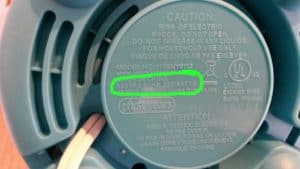
When traveling and the baby starts screaming
Typically when we travel and need to warm a bottle, we use one of the slow warmers that you wrap around the bottle and plug into the DC (cigarette lighter) outlet. They are great for what they are and I don’t really have any complaints when you think ahead to your baby’s needs and schedule.
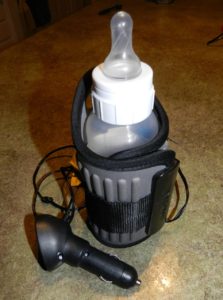
I highly recommend that traveling parents have this in their cars and leave it in there! You just never know when you’ll unexpectedly be stuck in traffic or need to rush to see a relative in the hospital for some reason. Having this in the car to keep your baby happy will be a lifesaver!
Sometimes though, we travel and just the process of packing up the entire vehicle to the roof for such a small person can leave you a bit scatterbrained and you forget to start the bottle in the travel warmer. Sometimes you make a scenic pit stop and the baby suddenly gets hungry. Sometimes you arrive at your destination and they lose power.
I can relate to all 3 of these scenarios and once again, the 800-watt power inverter saves the day.
My wife and I regularly travel from the Lower Peninsula of Michigan to the Upper Peninsula (UP) to visit her family in the most northern point of the UP. The winters are harsh, and the drive with small children/babies takes 10-12 hours with a few pit stops for everyone to stretch their legs and to get gas.
We’ve forgotten to get a bottle started because we were concerned with our checklist. We’ve stopped to walk around and eat at a park and had the baby get hungry a second time. We’ve even had the power go out once at her parent’s house.
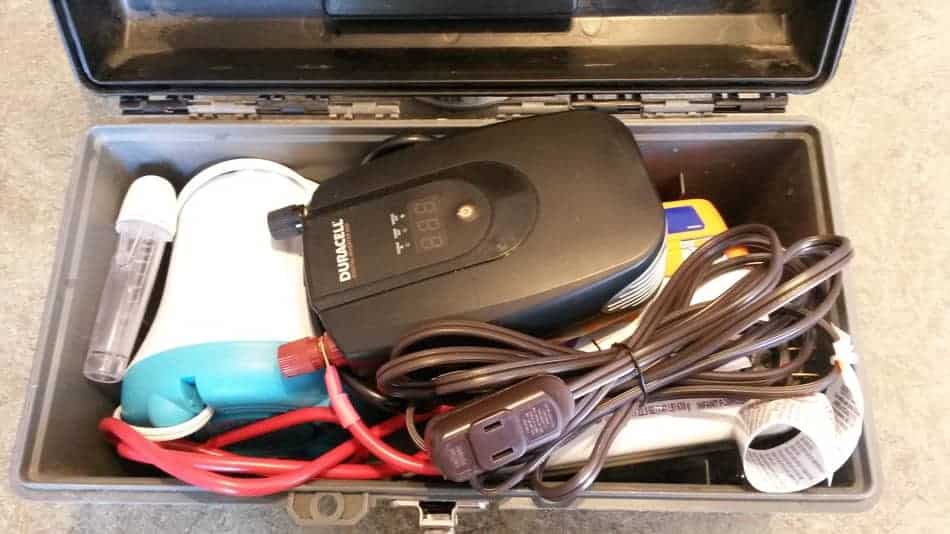
We simply pop the hood, hook up the inverter to the battery, run a cord through the car window, plug it into the home bottle warmer that we set on the center console and in 3 minutes we have a warm bottle! It’s a 5-minute process from start to finish with setup and takedown. Enough time for one of us to change a diaper while we’re waiting.
Remember that if your inverter comes with two sets of plugs (clamps for the battery or the cigarette lighter plug) that you need to use the clamps and hook directly to the battery! It would be convenient to simply plug the inverter into the cigarette lighter outlet and run the bottle warmer while driving, but the bottle warmer requires 300 watts. The cigarette lighter only supplies 150 watts. You will blow a fuse or worse. Unfortunately, you do need to stop to warm the bottle but it only takes 5 minutes from start to finish. Don’t try to do it while driving. Bad things happen to good people!
Advanced ways to warm a bottle when the power is out
Natural Gas or Propane
If you are blessed with natural gas or propane (which I now am, thankfully), you should have no problem getting the fuel to your stovetop but you’ll need to light it manually with an extended match. Once water is heated in a pot you can swirl your bottle in it until it reaches the desired temperature. If you’re using formula, you can just heat the water and then pour it into the bottle and mix. No need for the double-boiling action.
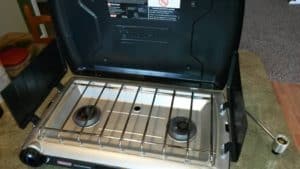
If you have an electric range, propane camp stoves (that use the 1lb cylinders) are a great way to warm up water in a pot and you can heat the bottles the same way as above. The warning label clearly states that the stoves are not to be used inside due to possible the fire hazards, gas leakage potential, and the possible build-up of the lethal gas carbon monoxide (CO). A patio or deck might be the best place to operate them.
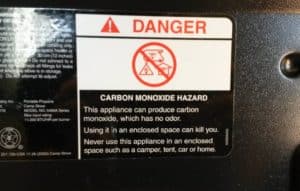
I’ve used them inside before but only for short durations (usually just to bring water to a boil or heat up a can of soup) and have never experienced a problem. When I’m done I just open a few windows for a cross breeze for a few minutes and get on with life.
I do not cook in excess with this unit indoors. I also have carbon monoxide detectors with battery backup that I place on the floor in the kitchen when I’m using the stove since CO is heavier than air. Also, you can check the hose fittings with soapy water for additional safety to catch any gas leaks.
A safer method that can be rated for indoor use (if you don’t want to use a propane camp stove) is a nifty butane stove. If I didn’t have natural gas hooked up, I would certainly buy one to give it a test. A 4-pack of the butane canisters is probably enough to get you through most power outages that you’ll ever encounter. You can check out my link here to my cooking resources page to check out my favorite butane stove.
Home Battery Backup
Of course, if you want to get a little fancier than your car battery, you can always create a DIY home battery backup bank from a deep cycle battery or two. I’ve personally scaled up to this with two golf cart batteries (check out this site on how to choose the right battery for you) and I have a system that is always at the standby and is ready to power my basic lighting needs, charge my devices, and warm bottles for 3-5 days before it’s at 50% and should ideally be recharged (depending on whether or not we use the TV intermittently).
With a dedicated system like this, there is no need to go outside to the car, and weather does not hinder it from working. I simply go to my basement, hook up the inverter, and run the extension cord upstairs with a lot of splitters for lights and devices. Super easy!
The system seems intimidating with all of the wires and electricity, and it should be shown a lot of respect because there can be dangers if you’re not careful, but it is very easy to create. I don’t consider myself gifted at all when it comes to electricity and mechanics, but I can usually MacGyver something together if I put a little thought into it. I knew nothing about battery backup power systems prior to 4 years ago. Teaching you what I’ve learned is the point of this blog!
Generator
Lastly, there’s always the generator to power your house and devices. Even the smallest generator will power your bottle warmer and then some. Remember though, if you’re just concerned with small things like a bottle warmer, a few lights, and charging cell phones — an 800-watt inverter effectively turns your car into a generator for you.
Conclusion
Warming a bottle doesn’t have to be the frustrating experience that it can be when you lose power or find yourself on a long commute. A little planning ahead can save you a lot of headaches. You certainly can’t go wrong with a travel warmer for the car and an 800-watt inverter for your kitchen warmer. Best of luck surviving your next power outage or road trip!
